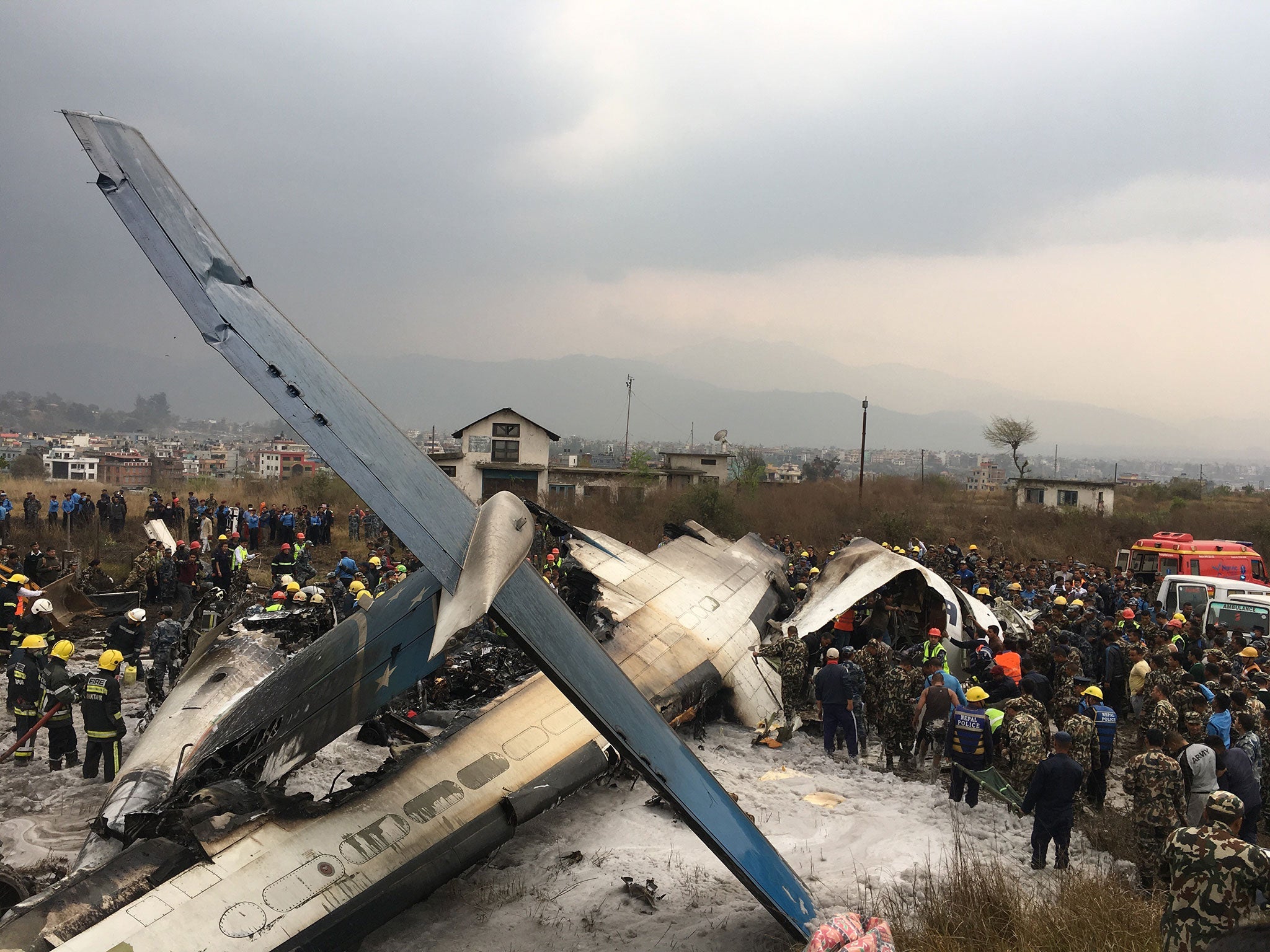Kathmandu plane crash: At least 50 dead as Bangladeshi jet crashes at Nepal international airport
'It was flying so low I thought it was going to run into the mountains... All of a sudden there was a blast and then another blast'

Your support helps us to tell the story
From reproductive rights to climate change to Big Tech, The Independent is on the ground when the story is developing. Whether it's investigating the financials of Elon Musk's pro-Trump PAC or producing our latest documentary, 'The A Word', which shines a light on the American women fighting for reproductive rights, we know how important it is to parse out the facts from the messaging.
At such a critical moment in US history, we need reporters on the ground. Your donation allows us to keep sending journalists to speak to both sides of the story.
The Independent is trusted by Americans across the entire political spectrum. And unlike many other quality news outlets, we choose not to lock Americans out of our reporting and analysis with paywalls. We believe quality journalism should be available to everyone, paid for by those who can afford it.
Your support makes all the difference.A plane carrying 71 people from Bangladesh swerved erratically and flew dangerously low before crashing and erupting in flames as it landed in Kathmandu, Nepal’s capital, on Monday, killing at least 50 people, officials and witnesses said.
A top airport official said the pilot of US-Bangla Airlines flight BS211 did not follow landing instructions from the control tower, and had approached the airport’s one runway from the wrong direction.
“The airplane was not properly aligned with the runway. The tower repeatedly asked if the pilot was OK and the reply was ‘yes’,” said Raj Kumar Chetri, the airport’s general manager.
But a recording of the conversations between the pilot and air traffic controllers indicated confusion over which direction the plane should land.
In the recording, posted by the air traffic monitoring website liveatc.net, conversation veered repeatedly over whether the pilot should land on the airport’s single runway from the south or the north.
Just before landing, the pilot asked: “Are we cleared to land?”
Moments later, the controller came back on, using a tone rarely heard in such conversations – perhaps even panic – and told the pilot: “I say again, turn!”
Seconds later, the controller ordered firetrucks onto the runway.
The exact number of dead and injured remained unclear amid the chaos of the crash and the rush of badly injured people to nearby hospitals, but Brig Gen Gokul Bhandari, the Nepal army spokesman, said it was clear that at least 50 people had died. Officials at Kathmandu Medical College, the closest hospital to the airport, said they were treating 16 survivors.
US-Bangla Airlines flight BS211 from Dhaka to Kathmandu was carrying 67 passengers and four crew members, according to an airline spokesman.
An AP journalist who arrived at the scene soon after the crash saw the twin-propeller plane broken into several large pieces, with dozens of firefighters and rescue workers clustered around the wreckage in a grassy field near the runway. Hundreds of people stood on a nearby hill, staring down at what remained of the Bombardier Dash 8 aircraft.
The plane swerved repeatedly as it prepared to land in Kathmandu, said Amanda Summers, an American working in Nepal. The crowded city sits in a valley in the Himalayan foothills.
“It was flying so low I thought it was going to run into the mountains,” said Ms Summers, who watched the crash from the terrace of her home office, not far from the airport. “All of a sudden there was a blast and then another blast.”

Fire crews put out the flames quickly, perhaps within a minute, she said, though for a time clouds of thick, dark smoke rose into the sky above the city.
The plane had circled Tribhuvan International Airport twice as it waited for clearance to land, Mohammed Selim, the airline’s manager in Kathmandu, told Dhaka-based Somoy TV by telephone. The plane was 17-years-old, company officials said.
Nitin Keyal was about to board a domestic flight when he saw the plane coming in.
“It was flying very low,” said Mr Keyal, a medical student. “Everyone just froze looking at it. You could tell it wasn’t a normal landing.”
He said it landed just off the runway, broke apart and burst into flames. “For a few minutes no one could believe what was happening. It was just terrible,” he said.
Most of the injured were brought to Kathmandu Medical College, where relatives wept as they awaited news.
Haran Saran was at the hospital hoping for news about his nephew, a medical student.
“He’s not on the list of injured people,” said Mr Saran, who did not want to give his nephew’s name. “We still have hope that there has been some mistake on the list, or he is in some other hospital.”
US-Bangla spokesman Kamrul Islam said the plane was carrying 32 passengers from Bangladesh, 33 from Nepal and one each from China and the Maldives. He did not provide the nationalities of the four crewmembers.
US-Bangla operates Boeing 737-800 and smaller Bombardier Dash 8 Q-400 planes.
The full-service airline is based in the Bangladeshi capital, Dhaka, and flies to several domestic and international destinations. The parent company, part of the US-Bangla Group, is involved in sectors that include real estate, education and agriculture.
Kathmandu’s airport has been the site of several deadly crashes. In September 2012, a Sita Air turboprop plane carrying trekkers to Mount Everest hit a bird and crashed shortly after takeoff, killing all 19 on board.
AP
Join our commenting forum
Join thought-provoking conversations, follow other Independent readers and see their replies
2Comments